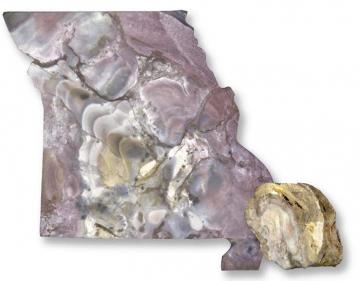Missouri Geological Survey Director: Carey Bridges, RG
Myriad visions appear to anyone hearing the word “Ozarks” — mountain folk; rough, hilly country; cool, bubbling springs; clear-flowing streams; float fishing for the wily bass; caves lined with stalactites and stalagmites; and — to rock and mineral collectors, hobbyists and lapidaries — a place to hunt for Mozarkite. The name Mozarkite is a contraction of “Mo” (Missouri), “zark” (Ozarks) and “ite” (meaning rock).

Mozarkite is a form of chert (flint) consisting essentially of silica (SiO2) with varying amounts of chalcedony (milky or grayish quartz). Mozarkite has won distinction as a particular form or variety of chert because of its unique variation of colors and its ability to take a high polish. Typically, the colors are different hues of red, pink and purple with varying tints of green, gray and brown. It is admired by lapidarists throughout the nation. Interest in collecting Mozarkite in Missouri started in the early 1950s, in Benton County.
The majority of occurrences are in west central Missouri, south of the Missouri River and west of the Lake of the Ozarks.
Mozarkite occurs in the Cotter Dolomite of Ordovician age, which means it is some 450 million years old. It is found in residual boulders in the soil on hillslopes, along ditches and in roadcuts where the boulders are exposed in the soil formed by weathering of the Cotter Dolomite.
In 1967, the 74th Missouri General Assembly designated the colorful Mozarkite as the official state rock.
Mozarkite is on display in our Ed Clark Museum of Missouri Geology.
Nothing in this document may be used to implement any enforcement action or levy any penalty unless promulgated by rule under chapter 536 or authorized by statute.
For more information
Geological Survey Program
Missouri Geological Survey
P.O. Box 250
Rolla, MO 65402-0250
United States
